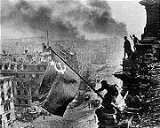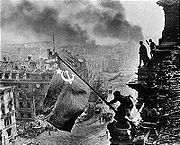
Yevgeny Khaldei
Encyclopedia
Yevgeny Khaldei was a Red Army
photographer, best known for his World War II
photograph of a Soviet soldier Raising a flag over the Reichstag
, in Berlin
, capital of the vanquished Nazi Germany
(1933–45).
, Ukraine
) and was obsessed with photography
since childhood, having built his first childhood camera with his grandmother's eyeglasses. He started working with the Soviet press agency TASS at the age of nineteen as a photographer.
Khaldei was also witness to several pivotal moments in history and is particularly reputed for his photographs during World War II and the Nuremberg Trials
. Khaldei worked with the TASS until 1949, when he was fired due to the growing anti-semitism by the Soviet state. For the next ten years, he worked as a private freelance photographer, focusing on scenes from everyday life. In 1959, he got a job again at the newspaper Pravda
, where he worked until he was forced to retire in 1970. Even though the flag over the Reichstag is one of his most famous works officials in the Soviet government never published who the photographer was. Khaldei's international fame dates from the fall of the Soviet Union, in 1991.
was being tried. Khaldei says about the Göring shot:
While Khaldei frequently staged or manipulated his photographs, he insisted that this was to signify the importance and add strength to a particular event. His work was also admired by the elites of the Soviet Union and he is renowned for creating commissioned portraits for State leaders such as Joseph Stalin
, Mikhail Gorbachev
and Boris Yeltsin
.
 Khaldei's most famous photo was of a Soviet Red Army soldier raising a flag above the German Reichstag
Khaldei's most famous photo was of a Soviet Red Army soldier raising a flag above the German Reichstag
at the end of World War II: the historic defeat of Nazi Germany in a war that cost the Soviet Union twenty millions lives; the magazine Ogonjok published the photograph on 13 May 1945. The Times
identified a similar photograph; an adolescent Red Army soldier, Aleksei Kovalyev, holds the Soviet flag atop the Reichstag, flanked by the soldiers, Abdulkhakim Ismailov
and Aleksei Goryachev. Ismailov's role in the photograph was identified by Kovalyev in a 1995 television documentary
. The Russian government honored Ismailov as a Hero of Russia in 1996.
The celebrated image is a re-enactment of an earlier flag-raising not photographed (the first men in the Reichstag were not in the photograph). The original flag raising was at 10.40 PM on 30 April 1945 when 23-year-old soldier Mikhail Minin
climbed the statue to install a flag pole to the Germania's, crown. As that occurred at night, the next day, Nazi soldiers took it down; they were defeated two days later. Finally, on 2 May 1945 photographer Khaldei scaled the Reichstag to take the photograph of two soldiers: Georgian Meliton Kantaria
and the Russian Mikhail Yegorov
. Later, the photograph was altered to hide evidence of looting (two watches, one on each wrist); later versions contained additional smoke in the sky, and a more visually impressive flag.
Red Army
The Workers' and Peasants' Red Army started out as the Soviet Union's revolutionary communist combat groups during the Russian Civil War of 1918-1922. It grew into the national army of the Soviet Union. By the 1930s the Red Army was among the largest armies in history.The "Red Army" name refers to...
photographer, best known for his World War II
World War II
World War II, or the Second World War , was a global conflict lasting from 1939 to 1945, involving most of the world's nations—including all of the great powers—eventually forming two opposing military alliances: the Allies and the Axis...
photograph of a Soviet soldier Raising a flag over the Reichstag
Raising a flag over the Reichstag
Raising a flag over the Reichstag is a historic World War II photograph taken during the Battle of Berlin on 2 May 1945, by Yevgeny Khaldei. It depicts several Soviet troops raising the flag of the Soviet Union atop the German Reichstag building. The photograph was instantly popular, being...
, in Berlin
Berlin
Berlin is the capital city of Germany and is one of the 16 states of Germany. With a population of 3.45 million people, Berlin is Germany's largest city. It is the second most populous city proper and the seventh most populous urban area in the European Union...
, capital of the vanquished Nazi Germany
Nazi Germany
Nazi Germany , also known as the Third Reich , but officially called German Reich from 1933 to 1943 and Greater German Reich from 26 June 1943 onward, is the name commonly used to refer to the state of Germany from 1933 to 1945, when it was a totalitarian dictatorship ruled by...
(1933–45).
Life
Khaldei was born in a Jewish family in Yuzovka (now DonetskDonetsk
Donetsk , is a large city in eastern Ukraine on the Kalmius river. Administratively, it is a center of Donetsk Oblast, while historically, it is the unofficial capital and largest city of the economic and cultural Donets Basin region...
, Ukraine
Ukraine
Ukraine is a country in Eastern Europe. It has an area of 603,628 km², making it the second largest contiguous country on the European continent, after Russia...
) and was obsessed with photography
Photography
Photography is the art, science and practice of creating durable images by recording light or other electromagnetic radiation, either electronically by means of an image sensor or chemically by means of a light-sensitive material such as photographic film...
since childhood, having built his first childhood camera with his grandmother's eyeglasses. He started working with the Soviet press agency TASS at the age of nineteen as a photographer.
Khaldei was also witness to several pivotal moments in history and is particularly reputed for his photographs during World War II and the Nuremberg Trials
Nuremberg Trials
The Nuremberg Trials were a series of military tribunals, held by the victorious Allied forces of World War II, most notable for the prosecution of prominent members of the political, military, and economic leadership of the defeated Nazi Germany....
. Khaldei worked with the TASS until 1949, when he was fired due to the growing anti-semitism by the Soviet state. For the next ten years, he worked as a private freelance photographer, focusing on scenes from everyday life. In 1959, he got a job again at the newspaper Pravda
Pravda
Pravda was a leading newspaper of the Soviet Union and an official organ of the Central Committee of the Communist Party between 1912 and 1991....
, where he worked until he was forced to retire in 1970. Even though the flag over the Reichstag is one of his most famous works officials in the Soviet government never published who the photographer was. Khaldei's international fame dates from the fall of the Soviet Union, in 1991.
Works
Khaldei's most renowned photographs were taken when he was a Red Army photographer from 1941 to 1946. Khaldei's photographs emphasised his feelings for the historic moments and his sense of humour. One of the more famous anecdotes was during the Nuremberg Trials, where Hermann GöringHermann Göring
Hermann Wilhelm Göring, was a German politician, military leader, and a leading member of the Nazi Party. He was a veteran of World War I as an ace fighter pilot, and a recipient of the coveted Pour le Mérite, also known as "The Blue Max"...
was being tried. Khaldei says about the Göring shot:
While Khaldei frequently staged or manipulated his photographs, he insisted that this was to signify the importance and add strength to a particular event. His work was also admired by the elites of the Soviet Union and he is renowned for creating commissioned portraits for State leaders such as Joseph Stalin
Joseph Stalin
Joseph Vissarionovich Stalin was the Premier of the Soviet Union from 6 May 1941 to 5 March 1953. He was among the Bolshevik revolutionaries who brought about the October Revolution and had held the position of first General Secretary of the Communist Party of the Soviet Union's Central Committee...
, Mikhail Gorbachev
Mikhail Gorbachev
Mikhail Sergeyevich Gorbachev is a former Soviet statesman, having served as General Secretary of the Communist Party of the Soviet Union from 1985 until 1991, and as the last head of state of the USSR, having served from 1988 until its dissolution in 1991...
and Boris Yeltsin
Boris Yeltsin
Boris Nikolayevich Yeltsin was the first President of the Russian Federation, serving from 1991 to 1999.Originally a supporter of Mikhail Gorbachev, Yeltsin emerged under the perestroika reforms as one of Gorbachev's most powerful political opponents. On 29 May 1990 he was elected the chairman of...
.
Red Army Reichstag photo

Raising a flag over the Reichstag
Raising a flag over the Reichstag is a historic World War II photograph taken during the Battle of Berlin on 2 May 1945, by Yevgeny Khaldei. It depicts several Soviet troops raising the flag of the Soviet Union atop the German Reichstag building. The photograph was instantly popular, being...
at the end of World War II: the historic defeat of Nazi Germany in a war that cost the Soviet Union twenty millions lives; the magazine Ogonjok published the photograph on 13 May 1945. The Times
The Times
The Times is a British daily national newspaper, first published in London in 1785 under the title The Daily Universal Register . The Times and its sister paper The Sunday Times are published by Times Newspapers Limited, a subsidiary since 1981 of News International...
identified a similar photograph; an adolescent Red Army soldier, Aleksei Kovalyev, holds the Soviet flag atop the Reichstag, flanked by the soldiers, Abdulkhakim Ismailov
Abdulkhakim Ismailov
Abdulkhakim Ismailov was a Soviet soldier within the Soviet Union's Red Army during World War II. He was photographed by Yevgeny Khaldei raising the flag of the Soviet Union over the Reichstag in Berlin in May 1945, three days before Nazi Germany's surrender.Abdulkhakim Ismailov, a native of...
and Aleksei Goryachev. Ismailov's role in the photograph was identified by Kovalyev in a 1995 television documentary
Television documentary
Documentary television is a genre of television programming that broadcasts documentaries.* Documentary television series, a television series which is made up of documentary episodes....
. The Russian government honored Ismailov as a Hero of Russia in 1996.
The celebrated image is a re-enactment of an earlier flag-raising not photographed (the first men in the Reichstag were not in the photograph). The original flag raising was at 10.40 PM on 30 April 1945 when 23-year-old soldier Mikhail Minin
Mikhail Minin
Mikhail Petrovich Minin was a Russian Soviet soldier who was the first to enter the Reichstag building on April 30, 1945 during the Battle of Berlin, and the first soldier to mount the flag on the Reichstag building at 10:40 pm.The iconic picture showing a Georgian soldier, Meliton Kantaria,...
climbed the statue to install a flag pole to the Germania's, crown. As that occurred at night, the next day, Nazi soldiers took it down; they were defeated two days later. Finally, on 2 May 1945 photographer Khaldei scaled the Reichstag to take the photograph of two soldiers: Georgian Meliton Kantaria
Meliton Kantaria
Meliton Varlamovich Kantaria or Kantariya , Hero of the Soviet Union , was a Georgian sergeant of the Soviet Army credited to have together with M. A...
and the Russian Mikhail Yegorov
M. A. Yegorov
Mikhail Yegorov, along with Meliton Kantaria, was one of the two soldiers credited with raising the Soviet flag over the Reichstag on the 2 May 1945 after the Battle of Berlin.- See also :*Raising the Flag on Iwo Jima...
. Later, the photograph was altered to hide evidence of looting (two watches, one on each wrist); later versions contained additional smoke in the sky, and a more visually impressive flag.
External links
- http://www.chaldej.de/

